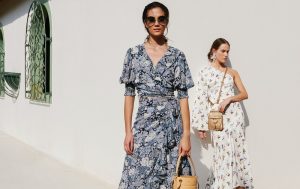
How Evening Dresses Have Evolved Through the Ages

Evening dresses are designed to be elegant and evoke a sense of opulence and desirability. Evening dresses have been a staple in the socialites closet for centuries and have evolved hugely through the years, especially since the 1950s.
From the brightly-colored, flower-patterned dresses of the ‘60s, the “everything we wear is brown or orange” part of the 1970s, to the huge ‘80s hairstyles and the all-denim outfits of the ‘90s, clothing has changed. One notable change that has occurred over the last few decades is that of the dress.
Evening Dresses in the 1940s and 50s
World War II came to an end in 1945, bringing about a new era of fashion experimentation, as people found themselves with a little less wartime restriction. Towards the end of the 1940s, Christian Dior popularized a style known as the “New Look,” namely full skirts with cinched waists.
This look likely became so popular so quickly because people were so eager to get away from the unflattering, boxy shapes of rationed wartime clothing. Waists were shown off, and tulle skirts gave a sense of opulence.
The ‘50s saw a more distinct gender divide, with clear masculine and feminine silhouettes being established. Despite this difference in shape, plaid was the most popular pattern in clothes for both men and women.
Evening dresses in the 1950s saw the popular Bardot-style first take precedence, and it’s a feminine and sexy neckline that is still incredibly popular today.
Evening Dresses in the 1960s
The 1960s saw a rise in the popularity of more toned-down streamline waists. With fashion becoming generally less conservative, shorter dresses became more popular, especially if they were trimmed with sequins or beads. Early in the decade, evening dresses became shorter and less tailored, though toward the end of the decade, full-length evening dresses returned to popularity.
Evening Dresses in the 1970s
It’s a well-known fact that the ‘70s saw some… interesting fabric choices, with shades of orange, brown, and khaki being popular in geometric patterns. Long, knitted dresses were popular throughout this decade, with people having had enough of tightly fitting, restrictive gowns, no matter how glamorous feminine they were. Instead of ultra-feminine, streamline dresses, the women of the ‘70s wore evening dresses with floral patterns, chiffon fabrics and long, billowing sleeves.
Evening Dresses in the 1980s
The 1980s was a decade of power dressing, with a lot of women dressing to assert their authority in male-dominated workplaces. This shift in fashion also made its way into evening dresses, with shoulder pads and bold patterns following suit (no pun intended). Women were taking up more space, and they were doing so with loud, embellished dresses and exaggerated silhouettes. Everything was big, puffy, and dramatic.
Evening Dresses in the 1990s
As fashion often does, the ‘80s trend of the big, coiffed hair, oversized pantsuits and eye-catching color palettes soon inverted itself, and fashionable evening dresses became smaller and less intrusive. Thin spaghetti straps were all the rage, with every celebrity donning a basic slip dress made in a soft crepe material. By the time the mid-1990s rolled around, we saw a reemergence of short, full-skirted and strapless evening gowns. As with the ‘80s, the fashion of hair echoed the dresses, with crimped and braided hairstyles taking on a playful, almost childlike tone.
Evening Dresses in the 2000s
The 2000s saw simplicity, structure, and questionable cuts. The red carpet was littered with “mistakes,” but the evening dresses that won out were classic in cut and in color. Thankfully, this is a trend that has continued throughout the 2010s and into the early 2020s!
The fashion of any era is often determined by socioeconomic and political factors and is echoed throughout the world. With the ending of a war giving women a taste for more feminine shaped evening dresses, to a rise in feminism resulting in women’s clothes and hair literally expanding, it’s clear that the evening gown we know today has changed and evolved a lot.
There’s no doubt that the idea of what makes a beautiful evening dress will change all over again, as it seems to do every ten years or so. It’s interesting to wonder how the “classic” evening dress will look ten, twenty or even fifty years from now…

